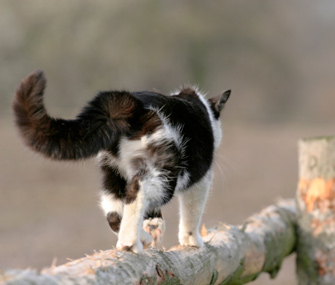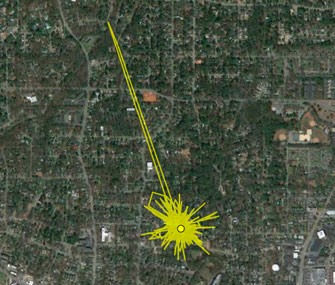Where Do Outdoor Cats Go? A GPS Tracking Study Can Tell You
Published on October 20, 2014

All featured products are chosen at the discretion of the Vetstreet editorial team and do not reflect a direct endorsement by the author. However, Vetstreet may make a small affiliate commission if you click through and make a purchase.
If your
cat goes outdoors, you wonder where he goes when he’s out of sight. Katie
Burke says of her cat Banjo, "When she was a teenage cat, she used to come home
smelling like cigarettes and perfume. I used to wonder where she had been and
kind of gave her a hard time about cheating on me."
Likewise, Becky Antworth and her husband couldn’t help but be curious about Roukus’ travels. "We seem to constantly be meeting neighbors where the reputation
of our cat precedes us," she says. "We’ll start talking to them and
they’ll say, ‘Oh, you don’t have a black cat, do you?’ ‘Yes, that’s our
cat.’ "
Scientists
wonder, too, although for different reasons — and now you can help them and possibly
answer some of your own questions at the same time.
Why
Track Cats?
There
was a time when most people let their pet cats wander outdoors. Now experts
recommend cats live inside for their own safety, but the ones who still go out
are at the center of a controversy: A 2012 article in the journal Nature Communications
estimated that roaming felines kill between 1.3 billion and 4 billion birds a
year in the United States.
Researchers
at North Carolina State University are at the start of what is already the
largest GPS tracking study of pet cats, in hopes of learning more about their
interactions with wildlife. Dr. Roland Kays says, "What we don’t know is
where they’re doing this hunting. That’s important, because if they’re hunting
in backyards and other developed areas, that might be less of a concern than if
they’re getting into our protected areas and parks and other areas that might
have more sensitive species."
So
they’re hoping to recruit owners all over the country for the Cat Tracker study, as well as
collaborating with researchers in Australia and New Zealand.
Mostly
Homebodies
Cat
owners who’ve volunteered to participate have found out some interesting things
about where their cats hang out.
"There
are certain houses that now I know that she frequents," Burke says.
"It’s funny to know she’s got her own friends and her own social life when
I’m gone to work during the day. One good friend said that she didn’t know
Banjo was hanging out by her house — she has her own cat, and they’re like
frenemies. There’s one other house I noticed she was frequenting. I was kind
of happy she was going there because they lost their cat a year ago. I thought maybe she’s keeping them company."

Like
the researchers, owners are curious about the distance cats go. Kays says that
although they haven’t yet done formal analyses of range sizes, cats don’t
go very far most of the time. "Most of them of them go two houses away, on
average," he says.
Burke’s
cat goes a little farther than that, but she was still relieved that it wasn’t
as far as she thought it might be. "I was really glad that she doesn’t
cross any major roads — except [for] now and then, she stays in the blocks around my
neighborhood, about two blocks around me on all sides."
Longer
Trips
There
are exceptions to the rule that cats stick close to home, though, which can be
interesting to both owners and scientists. Antworth says that her cat will walk
along the beach with her for almost a mile, and apparently she’s just as happy
to make such long treks on her own.
"It
was definitely a surprise to see how far she was going away from home, how
much she was going into other people’s yards and around others’ homes, and
just how active she was — how much time she spends making circles around the
territory," she says.

Even cats who are usually homebodies sometimes go on longer jaunts. Cat
Tracker team member Troi Perkins’ favorite story is about Chicha, who belongs
to Rob Dunn, another faculty member. "This cat is 14 years old, and
they had always mentioned that she seemed like she just laid around the backyard
and seemed kind of skittish about outdoor things," she says.
When
they got Chicha’s data, there was one trip so far away that they assumed it had
to be an equipment error, but Dunn looked at the map and saw that Chicha had
gone to a house where they used to live.
"The
cat had gone a mile away and hung out the entire day at their old
house," Perkins says. "It’s really cool from a scientist’s
perspective — cats really can remember stuff from a long time ago, and they
have this spatial memory." And from the cat owner’s perspective, it’s interesting too:
Perkins says that Dunn’s reaction was, "I wonder what kind of memory she
has about the old house? Does she have cat friends she goes and hangs out
with?"
The data the team is collecting has the potential to contribute to the study of
other questions about animal behavior and cognition. "As we get a big
enough sample, we’ll get enough of these anecdotes that we’ll be able to piece
together some interesting results about animal movement in general," says
Kays. "About how animals learn about their environments and how memory
affects their behavior."
Why Stay Close to Home?
When
you’re studying what might affect the movements of cats, it’s important to
remember that they are not just predators, but also potential prey. Coyotes are
big enough to catch cats, and Kays counts even owls as predators
after doing a little experiment.
"We
were curious what would attack a cat, so we went to Toys R Us and bought a cat
robot, and stuck it in the woods with a camera trap on it, " he says.
"An owl flew down and tried to carry it away."
Predators
may be having an effect on keeping cats away from more sensitive natural areas.
"There’s two main ways that predators can affect the prey species," Kays says. "One is direct: They can kill them, and that can reduce the
population. But there are also indirect effects, generally classified as fear
effects: They change the animals’ behavior. They don’t want to go into the
scary woods because there’s coyotes in there."
To
test these effects, the study’s leaders are particularly looking to get volunteers on
Long Island, New York. It’s the only place left in the continental United States that hasn’t yet
been colonized by coyotes, since it’s difficult for them to get there with New
York City in the way.
"Everyone
figures it’s a matter of time before they get there, but right now Long Island
is coyote free, and we want to try to get the ‘before’ data so we can compare
it to the ‘after’ data," Kays says.
How
to Participate
Previous studies have tracked cats’ movements, but they’ve been very
small. With around 60 participants thus far, Cat Tracker is already the largest. But
the researchers are hoping to get many more; their ambition is to sign up 1,000 cats.
It’s important to have large numbers because, although the average cat sticks
close to home, there are those individuals who roam much farther.
"If
you have many millions of cats, even if only 10 percent are moving far, that
could be a lot of cats out there in protected areas," Kays says.
"That’s why we want a large sample size, to be able to look at the
variability."
If
you live in the Raleigh-Durham area, you can borrow GPS units from the
research team. If you don’t, the website gives do-it-yourself instructions. For more information on how to join the study and see where your cat is roaming, check out the project description.
More on Vetstreet.com:





